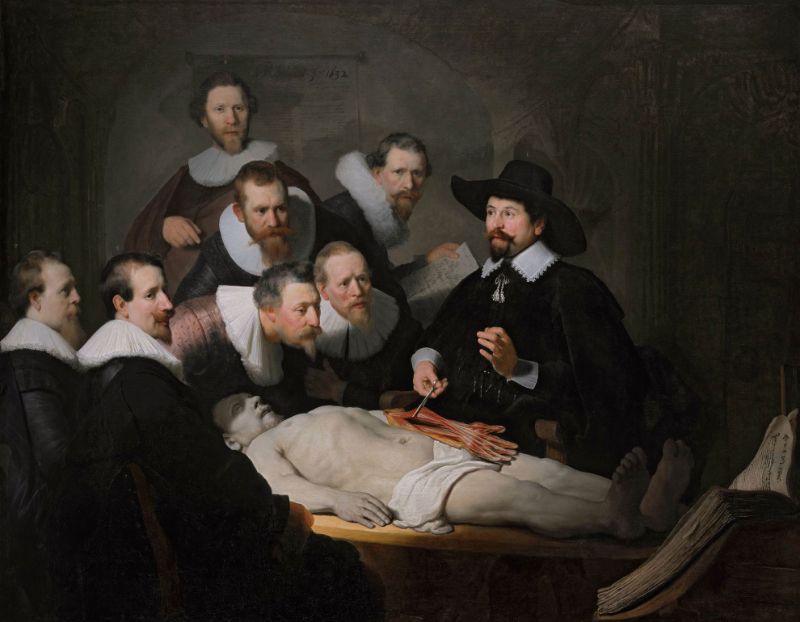Dr. Nicolaes Tulp’un Anatomi Dersi - Rembrandt van Rijn
Dr. Nicolaes Tulp’un Anatomi Dersi, 1632, Tuval üzerine yağlı boya, 216.5 x 169.5 cm, Mauritshuis, The Hague, Hollanda.
Rembrandt van Rijn 1632’de en önemli işlerinden biri olan “Dr. Tulp’un Anatomi Dersi” tablosunu yapar. Amsterdam Cerrahlar Loncası'nın isteği üzerine yaptığı bu eser Amsterdam’daki ilk önemli siparişlerindendir. Rembrandt’ın grup portresi niteliğindeki ilk anatomi dersi tablosudur. Genel grup portresi formundaki tablo Rembrandt’a büyük başarı kazandırmıştır.
Tabloda etrafı meslektaşlarıyla çevrili öğretim görevlisi Dr. Nicolaes Tulp anatomi dersinde görünmektedir. Resmin temel figürü olan Dr. Tulp dersini anlatırken Amsterdam Cerrahlar Loncası'nın yedi üyesi onu büyük bir dikkat ve ilgiyle izlemektedirler.
Dr. Tulp birlikteki üst mevkisininin de göstergesi olan geniş siperli bir şapka takmıştır. Sadece bir cerrah değil aynı zamanda şehir meclisinin ileri gelen bir üyesidir. Amsterdam’da modern anatomi çalışmalarınının başlatıcısı olarak bilinmektedir. Bazıları biletli de olabilen halka açık gösteri olarak düzenlenen anatomi dersleri vermektedir. Gösteriler çevresinde oturulabilecek oval biçimli Anatomi Tiyatrosu adı verilen amfiteatrlarda yapılmaktadır. Rembrandt’ın dönemi öncesinde yasak olan kadavra incelemeleri onun döneminde suçluların kadavralarıyla sınırlandırılmıştır. Resme konu olan ders Ocak 1632’de üç gün sürmüştür. Resimdeki kadavranın sahibi 1632 kışında bir palto hırsızlığı suçundan idam edilen Adriaen Adriaansz’dır.
Sahne çok canlıdır. Piramidal figür yığını, diyagonal bir yerleştirme içindedir. Dr. Tulp dersinde pratikve teorik anlatımı birlikte kullanmaktadır. Sağ eli ve parmaklarıyla kadavranın kas ve bilek hareketlerini gösterirken sol eli ve parmaklarıyla uygulama konusunu belirtmektedir. Pür dikkat gözlem yapan Cerrahlar Loncası'nın yedi üyesi kadavra, kitap ve Tulp'un ellerine odaklanmaktadırlar. Her bir figürün pozisyon ve ifadesi birbirinden farklıdır. Sadece biri seyirciye direk bakıyormuş gibidir. Bir diğer figürün elindeki kâğıtta derse katılanların adları yazılıdır. Resim, bu açıdan tarihsel bir belge niteliği de taşımaktadır.
Resmin sağ alt kısmında kadavranın ayak ucunda üyelerden en az birinin baktığı yerde açık duran bir anatomi kitabı vardır. Bu kitap on altıncı yüzyılda yaşamış anatomist Andreas Vesalius’un devrim yaratan De Humani Corporis Fabrica (1543) adlı anatomi kitabıdır. Anatomist Vesalius'un çalışmaları dışında beden üzerinde disseksiyon tabloda ilk kez sanatsal bir yapıt olarak işlenmiştir.
Figürlerin soluk yüzleri ve ceset derisi koyu arka planla bir tezat oluşturmaktadır. Atmosferi etkili oluşturmak ve dikkatin dağılmaması için arka plan nötr ve silik tasarlanmıştı. Dikkat çekici birdiğer nokta da otopsi sırasında ışığın günümüzdeki gibi dışardan bedene doğru değil bedenden dışarıya yayılmasıdır. Adrianson’un bedeni, odaktadır ve ışığın da kaynağıdır.
Kadavranın başının bedenin merkezinde değil de göğüs kafesinin üstünde sağa doğru olması ve boyun kısmının görülmemesi dikkate değer olmuştur. Adrianson’un idam sonucu kırılan boynu resimde görülmemektedir. Rembrandt’ın resmin ana fikrini dağıtmamak için kırık boynu resmetmediği söylenegelmiştir.
Dr. Tulp’un kesime geleneksel anatomidekinden farklı olarak kadavranın kolundan başlamaktadır. Kadavranın sol kolu dışında başka hiçbir yer kesilmemiştir. Böylece göğüsten başlanıp kol ve bacaklara geçilen geleneksel protokole aykırı düşenresim devrimci bir nitelik kazanmıştır.
Rembrandt’ın anatomi dersleri çalışmalarında iskelet kadavrası kullanmaması onun en ayrıksı özeliğiydi. Dr. Tulp’a kadar yapılan tüm anatomi dersi resimlerinde iskelet kullanılmıştı. Böylece Rembrant köklü bir geleneği tersyüz eden, ayrı bir tarz ve form yaratmıştı. Bu resimden sonra artık kadavralar iskelet şeklinde resmedilmeyeceklerdi...
Yararlanılan Kaynaklar;
Erdoğan, C.E., (2016). Sanatın Büyük Ustaları Rembrandt, Birinci Baskı, Hayalperest Yayınevi, İstanbul.
Turani, A., (2010). Dünya Sanat Tarihi, On Dördüncü Baskı, Remzi Kitabevi, İstanbul.
Altuna, S., (2013). Ünlü Ressamlar Hayatları ve Eserleri, Birinci Baskı, Hayalperest Yayınevi, İstanbul.
Spence, D., (2012). Büyük Ressamlar Rembrandt, İkinci Basım, Koleksiyon Yayıncılık, İstanbul.
Lunday, E., (2013). Büyük Sanatçıların Gizli Hayatları, Beşinci Baskı, Domingo Yayınevi, İstanbul.
Gomm, S.C., (2014). Sanat Sanatın Gizli Dili, Birinci Baskı, İnkılap Kitabevi, İstanbul.
Soyşekerci, S., (2015). Beden Sanatı Rembrandt ve Anatomi Dersleri, Birinci Baskı, Doğu Batı Yayınları, Ankara.
-----------., (2007). Rembrandt, Birinci Baskı, Boyut Yayın Grubu, İstanbul.













